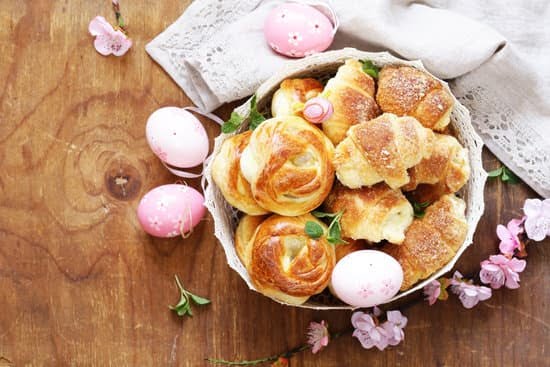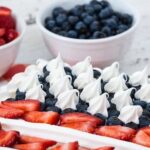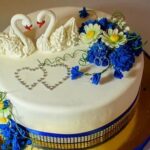Are you looking to elevate your baking skills and learn how to decorate a basic cake like a pro? Decorating a basic cake can seem daunting, but with the right techniques and guidance, you can turn a simple dessert into a stunning masterpiece. In this article, we will provide you with comprehensive tips and step-by-step guides on how to decorate a basic cake, from choosing the right frosting to adding final touches for a show-stopping presentation.
First, we will delve into the essential tools needed for decorating a basic cake. From piping bags to offset spatulas, we will provide you with a comprehensive guide on the must-have tools that will make your decorating process seamless and efficient.
Next, we will discuss the importance of choosing the right frosting for your base and provide you with tips on perfecting it. We’ll also cover techniques for smoothing and leveling your cake to create a stunning base before moving on to mastering different piping techniques and using fondant for a professional finish. Additionally, we’ll offer tips for using edible decorations such as sprinkles and edible glitter to add flair to your creation.
By the end of this article, you’ll have all the knowledge you need to transform a basic cake into a showstopper that is sure to impress your friends and family. So, let’s get started on our journey to mastering the art of decorating basic cakes.
Essential Tools for Decorating
When it comes to decorating a basic cake, having the right tools is essential for achieving professional-looking results. Whether you’re a beginner or an experienced baker, having a comprehensive guide to essential decorating tools can elevate your cake decorating game to the next level.
One of the most important tools for cake decorating is a turntable, which allows you to easily rotate the cake as you work on it, ensuring even coverage and smooth finishes. Other essential tools include offset spatulas for spreading and smoothing frosting, piping bags and tips for creating decorative designs, and a bench scraper for achieving sharp edges and straight sides on your cakes.
In addition to these basic tools, it’s also important to have a good set of measuring spoons and cups for accurately measuring ingredients, as well as a sturdy cake stand for displaying your finished masterpiece. Investing in quality tools will not only make the decorating process easier and more enjoyable but will also give you better results overall.
Finally, don’t forget about storage containers to keep your frosting and decorations fresh between uses, as well as a rotating cake stand for easy access while working on intricate designs. By having all the right tools at your disposal, you’ll be well-equipped to create beautifully decorated cakes that are sure to impress.
| Essential Decorating Tools | Description |
|---|---|
| Turntable | Allows for easy rotation of the cake while decorating |
| Offset spatulas | For spreading and smoothing frosting |
| Piping bags and tips | For creating decorative designs with frosting |
| Bench scraper | For achieving sharp edges and straight sides on cakes |
Choosing the Right Frosting
When it comes to decorating a basic cake, choosing the right frosting is essential for achieving a perfect base. The type of frosting you use can greatly impact the overall look and taste of your cake. Whether you prefer a classic buttercream, rich ganache, or smooth fondant, there are a few tips to keep in mind to ensure that your frosting perfectly complements your cake.
One important tip for choosing the right frosting is to consider the flavor and texture of your cake. If you have a light and fluffy vanilla cake, a silky Swiss meringue buttercream might be the perfect match. For a dense chocolate cake, a decadent chocolate ganache could be just what you need. Matching the flavors and textures will help create a harmonious balance between the cake and frosting.
Another crucial aspect to consider when selecting the right frosting is the design and theme of your cake. If you’re going for a rustic or homemade look, a simple American buttercream with its slightly grainy texture might be suitable. On the other hand, if you’re aiming for an elegant and sleek finish, fondant or Italian meringue buttercream could be more fitting.
In addition to flavor and design, it’s also important to take into account any dietary restrictions or preferences of those who will be enjoying the cake. With many different options available such as vegan buttercreams and dairy-free frostings, there are plenty of ways to accommodate various dietary needs while still achieving delicious results on your decorated basic cake.
Creating a Stunning Base
When it comes to decorating a basic cake, one of the most important aspects is achieving a smooth and level base. This provides the perfect canvas for adding your decorative touches and ensures a professional finish to your creation. Here are some essential techniques for achieving a stunning base for your basic cake:
Leveling the Cake
Before you can begin decorating, it’s crucial to ensure that your cake layers are level. Use a long serrated knife or a cake leveler to carefully trim off any domed tops from each layer. This will create a flat surface, making it easier to stack and frost your cake evenly.
Crumb Coating
After leveling your cake, apply a thin layer of frosting all over the top and sides of the cake. This initial coat, known as a crumb coat, helps to seal in any loose crumbs and provides a smooth surface for the final layer of frosting. Use an offset spatula to spread the frosting evenly, filling in any gaps or uneven areas.
Smoothing the Frosting
To achieve a perfectly smooth finish on your frosted cake, invest in an icing smoother or bench scraper. Gently but firmly press the smoother against the sides of the cake while turning it on its stand. Repeat this process until the frosting is evenly spread and any air bubbles are removed. For the top of the cake, use an offset spatula to smooth out any imperfections.
By mastering these techniques for creating a stunning base, you can elevate even the most basic cake into an impressive work of art. With practice and patience, you’ll be able to achieve professional-looking results every time.
Adding Flair With Piping
Piping is a great way to add visually appealing designs and textures to your basic cake. Whether you’re going for a simple, elegant look or something more intricate and complex, mastering different piping techniques can take your cake decorating skills to the next level.
Choosing the Right Piping Tip
The first step in mastering piping techniques is choosing the right piping tip for the design you have in mind. Different tips create different effects, so it’s essential to have a variety of tips on hand. For example, a round tip is perfect for creating smooth lines and dots, while a star tip can be used to create beautiful rosettes and borders. Experimenting with different tips will help you become familiar with the effects they produce.
Practicing Your Technique
Before jumping into decorating your cake, it’s important to practice your piping technique on a separate surface such as parchment paper or even on a plate. This will help you get a feel for how much pressure to apply and how quickly to move your hand. It’s also a great way to experiment with different designs and patterns before committing to decorating your cake.
Creative Piping Designs
Once you’ve mastered the basics of piping, there are countless creative designs you can try on your basic cake. From delicate flowers to intricate lace patterns, piping offers endless possibilities for adding flair and personality to your cake. Don’t be afraid to get creative and experiment with different combinations of tips, colors, and techniques to achieve the look you desire.
By mastering different piping techniques, you can elevate a basic cake into a stunning work of art that will impress any audience. Whether you’re aiming for simplicity or extravagance in your designs, practicing and experimenting with various piping techniques will enable you to take your cake decorating skills to new heights.
Decorating With Fondant
Fondant is a versatile and popular option for decorating cakes, as it allows for a smooth and professional finish. Here’s a step-by-step guide on how to decorate a basic cake using fondant:
1. Prepare the cake: Before applying fondant, make sure your cake base is smooth and even. You can use a simple buttercream frosting as a base to help the fondant stick to the cake.
2. Roll out the fondant: Dust your work surface with powdered sugar, then roll out the fondant into a thin, even layer using a rolling pin. Make sure the fondant is large enough to cover the entire cake.
3. Apply the fondant: Carefully lift the rolled out fondant and drape it over the cake. Gently smooth it over the top and sides of the cake, using your hands to remove any air bubbles or wrinkles.
4. Trim and decorate: Use a sharp knife to trim off any excess fondant from around the base of the cake. Now you can get creative with additional decorations such as cut-out shapes, edible paint, or fondant sculpting tools.
5. Tips for success: To prevent drying out, always keep unused fondant covered when working with it. If you’re working with multiple colors, consider using gel food coloring for vibrant shades without affecting the texture of the fondant.
By following these steps, you can achieve a professional-looking finish when decorating your basic cake with fondant.
Now that you’ve mastered how to decorate a basic cake using fondant, you can take your skills further with advanced techniques such as marbling, ombre effects, or intricate detailing for special occasions like weddings or birthdays. Fondant provides endless possibilities for creating stunning and customized designs on your baked creations.
Using Edible Decorations
Decorating a basic cake with edible decorations can take your creation to the next level. Whether you’re looking to add a pop of color, some sparkle, or just a fun texture, there are many options for using sprinkles, edible glitter, and more to enhance the look of your cake.
Here are some tips for using edible decorations effectively:
- Sprinkles: Sprinkles come in all shapes, sizes, and colors, making them a versatile option for adding visual interest to your cake. Consider using themed sprinkles for special occasions or holidays. When applying sprinkles to your cake, gently press them into the frosting to ensure they stick properly.
- Edible Glitter: For a touch of glamor and sparkle, edible glitter can be used to add a shimmering effect to your cake. Use a food-safe brush to lightly dust the glitter over the frosted surface of your cake. Be mindful not to overdo it – a little goes a long way with edible glitter.
- Other Edible Decorations: Consider using items such as edible pearls, gold leaf, or colored sugar crystals to add dimension and creativity to your basic cake. These decorations can be strategically placed on the cake’s surface or around the edges for an eye-catching effect.
With these tips in mind, you can experiment with different types of edible decorations to create a beautifully adorned basic cake that is sure to impress.
Remember that while using edible decorations can elevate the appearance of your basic cake, it’s important not to go overboard. Balance is key when it comes to decorating with sprinkles, edible glitter, and other embellishments. Ultimately, have fun experimenting with different options and finding what works best for your personal taste and style.
Final Touches and Presentation
In conclusion, the final touches and presentation are crucial in making your basic cake truly stand out. After mastering the essential tools for decorating and choosing the right frosting, it’s time to put the finishing touches on your creation. Whether it’s a simple buttercream swirl, an elegant fondant design, or a sprinkle of edible decorations, these final details can elevate your basic cake into a showstopper.
As you put the final touches on your cake, remember that presentation is key. A beautifully decorated cake can be further enhanced by displaying it on an attractive cake stand or adding fresh flowers or fruit as a garnish. The way you present your cake can make all the difference in leaving a lasting impression on your guests.
Ultimately, learning how to decorate a basic cake is not just about following specific techniques; it’s also about unleashing your creativity and personal style. Experiment with different piping techniques, explore various edible decorations, and don’t be afraid to think outside the box when it comes to presenting your finished creation. With practice and patience, you’ll soon find yourself transforming plain cakes into stunning showstoppers that will impress everyone who sees – and tastes – them.
Frequently Asked Questions
How Do You Decorate a Cake in a Simple Way?
Decorating a cake in a simple way can be achieved by using some basic techniques and tools. One approach is to use a piping bag and frosting to create swirls or rosettes on top of the cake. Another idea is to sprinkle some edible decorations like colored sugar or sprinkles on the frosting for a quick and easy finish.
How Do You Make a Plain Cake Look Nice?
Making a plain cake look nice can be as easy as adding a dusting of powdered sugar on top, arranging fresh fruit slices or berries in an attractive pattern, or drizzling a simple glaze over the cake for a glossy finish.
Even just adding a dollop of whipped cream or a scoop of ice cream alongside the cake can elevate its presentation.
What Does a Beginner Need for Cake Decorating?
For beginners in cake decorating, it’s important to have some essential tools and supplies on hand. This includes items such as offset spatulas for spreading frosting, piping bags and tips for creating designs, various food coloring gels for tinting frosting, and basic molds or stencils for shaping decorations.
It’s also helpful to have an assortment of sprinkles, edible pearls, and other decorative elements to add flair to the finished product. Learning some foundational techniques through online tutorials or beginner classes can also be beneficial for getting started in cake decorating.

Welcome to our cake decorating blog! My name is Destiny Flores, and I am the proud owner of a cake decorating business named Cake Karma. Our mission is to provide delicious, beautiful cakes for all occasions. We specialize in creating custom cakes that are tailored specifically to each customer’s individual needs and tastes.





